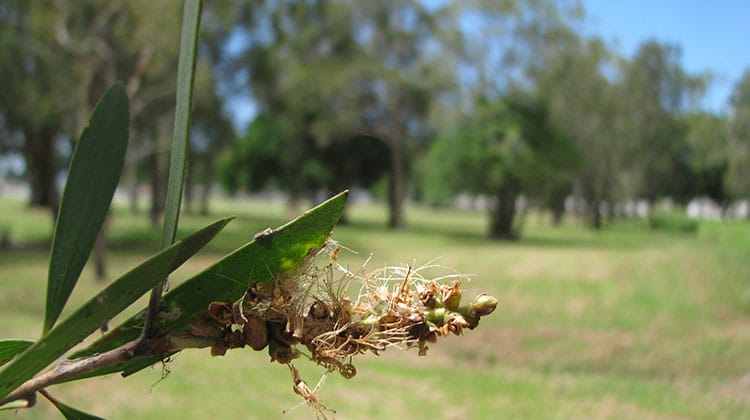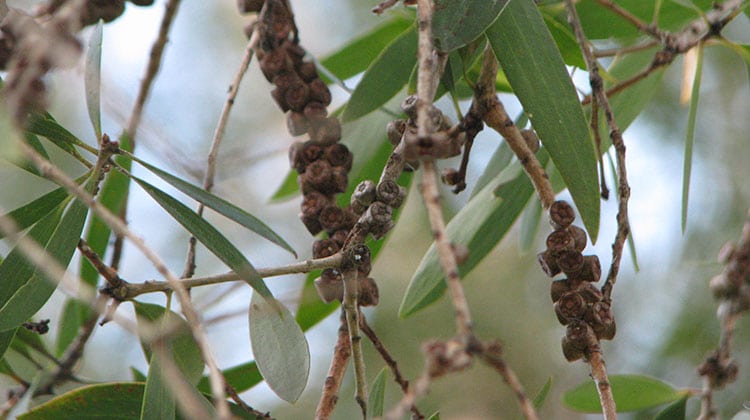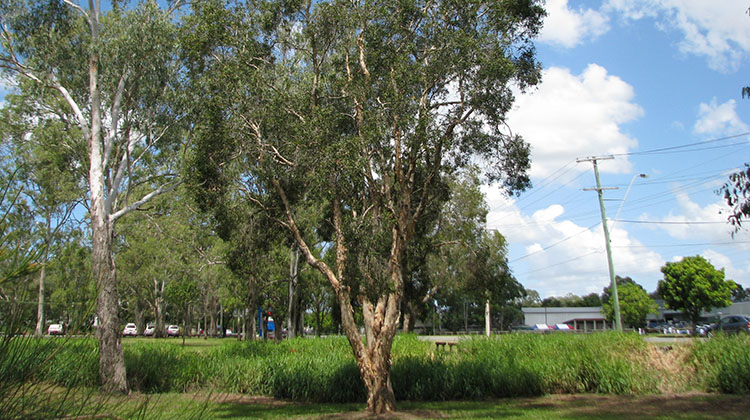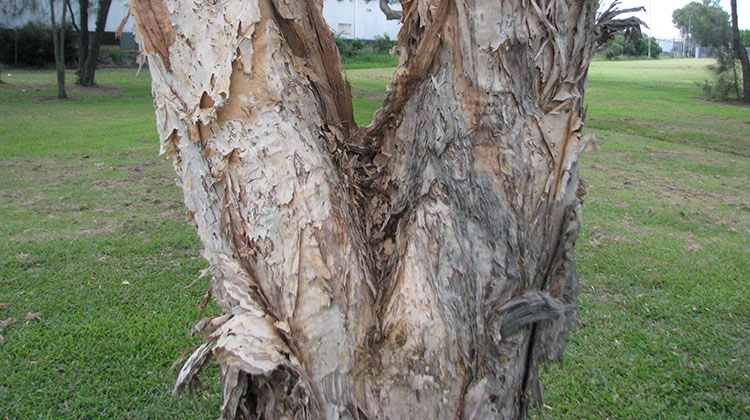Melaleuca quinquenervia
Family: Myrtaceae Origin: Australia, New Caledonia and Papua New Guinea
Broad-leaved paperbark, or niaouli, is a medium-sized, fast-growing tree native to Papua New Guinea, New Caledonia and the eastern coast of Australia–from Botany Bay to Queensland and the Northern Territory. Paperbarks have also spread to the Everglades of Florida, where it is deemed a pest. It’s bark is layered and peeling, much like a birch tree, and has a paper-quality to it, hence its name.
Arboriculture
Grow form
Paperbark grows up to 8 to 10 metres high with a canopy 5 to 10m wide. The leaves are leathery and either dull or gray-green in color.
Trunk
The bark is beige, white, or gray and looks like thickly-layered paper. Note the codominant leaders with the inclusion of bark between them. This is a common fault with paperbarks and can often lead to failure. In valuable trees cabling or bracing may be necessary. Bark should not be allowed to accumulate in the join to avoid rot.
Flowering
Broad-leaved paperbarks flower from the beginning from spring to early autumn: September to March in Australia. The white or cream flowers are arranged in cylindrical brushes some 4-8cm long and 2-3cm wide at or near the end of the branches.
 Foliage
Foliage
Paperbark leaves are arranged alternately, dull green or gray-green in color, and leathery in appearance. The leaves are 5 to 10 cm long and ovate to obovate in shape. Paperbark leaves are evergreen, lanceolate, simple and short-stalked, parallel-veined, alternate in arrangement, and aromatic when crushed.
Fruits
Broad-leaved paperbark fruits are small, round woody capsules containing 200 to 300 seeds. They can be harvested by leaving the ‘gum nuts’ on a window sill for a week or two, at which time the seeds will fall out.
 Management
Management
Propagation
The paperbark usually propagates by sexual seed production. The species matures rapidly, and is capable of flowering within three (and as little as two) years of germination and as frequently as five times each year. Paperbark grows naturally in silty, swampy soil, such as on the borders of estuaries or swamps.
Cultivation
The paperbark tree is cultivated for a variety of purposes, especially by indigenous Australians. A brew made from the leaves was used to treat colds and other sicknesses. The papery bark was used to make coolamons, shelters, and the lining of ground ovens. The timber can be used for outdoor structures such as fencing, because it is tolerant of being water saturated.
To avoid being infested by borers they should be well-cared for. Ideally, mulch from near the trunk to the drip-line of the tree. Avoid piling mulch against the trunk to prevent insects accessing the root crown through the mulch. Contact an arborist for an assessment if it is near your house or an area where people frequent.



Dear david,
Please see my question from 2/11/23.
Can you provide an answer or direct me to a useful source of information, please.
Thanks,
Josie
Hi,
I planted 5 paperbarks at the bottom of my garden in Brisbane 3 years ago. They are now approximately 4 metres tall and appear healthy but still have very thin trunks. They have had the benefit of 3 La Nina years. They have been mulched.
When will they thicken up? How can I encourage their growth? Should I be trying to create damper conditions?
We have a beaut older paperbark tree which has grown rather rapidly over the past 3 years. Do these trees loose their limbs as we often park our car underneath it ?
Regards. Graham
Hi David
We live on the Sunshine Coast and our neighbours beach side have what we thought was a rather large Melaleuca. after reading your article, I realise it still has a long way to go. If it grows to its full potential it will completely obscure our view of the ocean and coastline which is currently unobstructed. As we are high on a hill, the tree could probably reach 8m without an issue, but any higher and we’ll be very disappointed as the owners (from Melbourne) aren’t hearing anything about trimming (even at our expense). Just wondering what the root system does over years. It’s wedged between our fence and their pool.
Hi Nel, tree protection laws on the Sunshine Coast are very strict, permits are required to remove a tree and cutting the top off any tree is illegal and carries significant penalties if you’re caught wilfully damaging protected native vegetation.
Hi There,
Are these trees protected? We are looking to add a carport to our house and unfortunately the tree has been poorly positioned.
Thanks
Hi David, thanks for the article. We have had one of these trees in North Brisbane for about 3 years. It flowered in Dec 2016 and Mar 2019. But since then it just seems stunted. Not much growth and no flowers. Do you know why this could be or what we could do to help it along? Thanks
Hi David, I just came across your article when researching if a Norfolk pine will withstand heavy pruning. Recently our beautiful established pine was mistakenly pruned while we were not at our holiday house in Mollymook (south coast NSW). The horizontal branches have been cut half way along their length on the bottom 2/3 of our tree. I’m heartbroken. Can the tree survive a prune like this. I don’t know what I should do
A non-adjoining neighbour has asked us to severely lop our beautiful 16 year-old broadleaved paperbark as he does not appreciate it being in the foreground of his city view (it partially obscures about 20%, horizontally, of his magnificent city panorama). The tree grew 2-3m in the past year to its current height of approx 8-9m, following the storm-loss of a neighbouring tree. Does this variety of tree respond well to lopping? We would appreciate some advice on pros and cons of lopping as it is a highly valued tree from our perspective and that of two immediately adjoining neighbours. Location is Brisbane.
Hi Daniel. They can recover well if pruned by a well-trained arborist but pruning by a tree lopper will result in either dead wood or shoots that will fail later.
Pruning trees by poorly trained Arborists can damage adjacent trees, even to the point of tearing out the rigging points and damaging fences as a result of lack of knowledge and skill.
You’ll also need to check for any protection overlays because removing and/or damaging protected trees can result in fines by council.
Thank you for your article. Do you know what causes the holes /circular marks in the bark?
Hi Kylie. They are the exit holes of borers. Paperbarks are strong and can withstand a considerable infestation of borers, though they have their limits. It’s important to maintain them in good health.